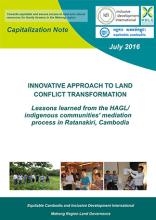Land Library
Welcome to the Land Portal Library. Explore our vast collection of open-access resources (over 74,000) including reports, journal articles, research papers, peer-reviewed publications, legal documents, videos and much more.
/ library resources
Showing items 1 through 9 of 228.While Burma’s ethnic states are blessed with a wealth of natural resources and biodiversity, they
have been cursed by the unsustainable extraction and sale of those resources, which has fuelled
Myanmar may soon face a land conflict epidemic as a result of the growing influx of investments and
the consequent demand for land, unless laws and policies that adequately address land rights issues
are urgently adopted and implemented.
Conclusions: "Amnesty International’s latest research shows that hundreds of people close to the giant Letpadaung mine continue to face the risk of forced eviction from their farmland, and in the case of four villages, from their homes as well.
This video is part of one of the major activities of the L&A initiative “Collective Learning on Land Conflict Resolution” in Cambodia. It shows how important the solidarity of villagers is important to prevent land grabbing.
GRAIN is a small international non-profit organisation that works to support small farmers and social movements in their struggles for community-controlled and biodiversity-based food systems.
In Burma, where 70 percent of people earn a living through agriculture, securing land is often equivalent to securing a livelihood.
A Comparative Study of Land Rights Systems in Southeast
Asia and the Potential of National and International Legal
Frameworks and Guidelines....."Land rights systems in Southeast Asia are in constant
In Cambodia, the majority of the population is still composed of smallholder family farmers. 54% of the total labour force is employed in agriculture. They have access to 3.6 million ha of land, representing 19% of the country’s total land.
In the Mekong region, conflicts between local communities and large scale land concessions are widespread. They are often difficult to solve.




